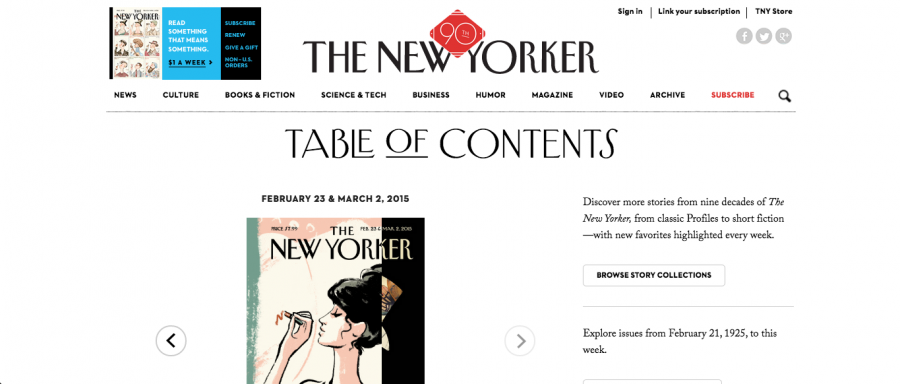Scholastic Journalism Week: How I get my inspiration for tjTODAY
Photo courtesy of www.newyorker.com. Every month, journalists in tjTODAY get ideas for articles and layout using various resources.
February 28, 2015
In celebration of this year’s Scholastic Journalism Week (SJW2015), tjTODAY has been participating in the appreciation of journalism in the Jefferson community, recognizing the importance of student media and press in schools.
As a current journalist and member of tjTODAY, I decided to celebrate the week by introducing an interesting aspect of being a student journalist: the process of getting inspiration for the upcoming issue, or for any online articles.
Each tjTODAY issue provides roughly a week of time to think about article and layout ideas, and every time it starts with two blank, white pages and a question: ‘Well, how am I going to fill these pages?’
1. Newspapers and magazines
The first step I take when brainstorming for ideas is visiting the online websites of professional newspapers and magazines trying to find the latest trends or issues in the media. As a journalist, it is essential to connect current events with the specific audience reading the publication.
I especially focus on the “education” and “technology” sections of “The New York Times,” since the topics closely relate to the interests of the Jefferson population and students, who usually focus on scientific studies and are easily exposed to new forms of technology.
If I use “The New York Times” to figure out what is going on around the world, I read “The New Yorker” to gain deeper insights into some of the societal and cultural characteristics of the United States and beyond. “The New Yorker” showcases current issues with a more thorough and detailed view. Refusing to follow the trend of fast news reporting, the magazine tries to tell the entire story and make them actually understandable to the public. Reading the rarely revealed details in some of their articles allows me to think of unexpected new ideas.
2. Pinterest
Pinterest is always the answer to any of my design dilemma. I can never leave out Pinterest when I need design ideas–it is a reservoir of numerous designs, images and illustrations that help me to visualize my section as something other than two blank, nonexistent pages. The topics that I search for range from “magazine design” and “infographics” to “movies” and “chemistry.” Anything that is related to the article that I am placing into my section becomes a valuable resource for design and layout. Really, the variety of articles that we write allows anything possible: Who knows what we would be covering next?
3. Facebook & Social Media
The best way to get the latest information about the school is through Facebook. When I search for article ideas, especially those about Jefferson, I visit the school class groups to get the latest news about the school, which range from schedule changes and school cancellations to new clubs and bake sales. Facebook is sometimes the best way to get a sense of students’ opinions and views. Since it is difficult to get a sense of what the students are thinking solely through my personal network, social media allows me to see the bigger picture of student reactions. Other than Facebook, I also use Twitter and Instagram to be in trend with people outside my community.
4. Student conversations
The fastest way to get an idea about what is the center of students’ interest is by talking to others and being attentive to their conversations. Sometimes they can be about how difficult physics is, or how they are preparing for International Night (I-Nite), but in all, they directly represent what the school and the students are thinking.
5. Myself
Sometimes, when I am out of ideas and have no energy to look for them, I sometimes reflect on myself. I ask questions such as: ‘What am I interested in?’, ‘What is my opinion on this issue?’, ‘What are some cool things happening in the school that I would like to report on?’ Just stopping for a moment and asking questions to myself sometimes give me ideas to write about, especially for opinion and entertainment articles.






